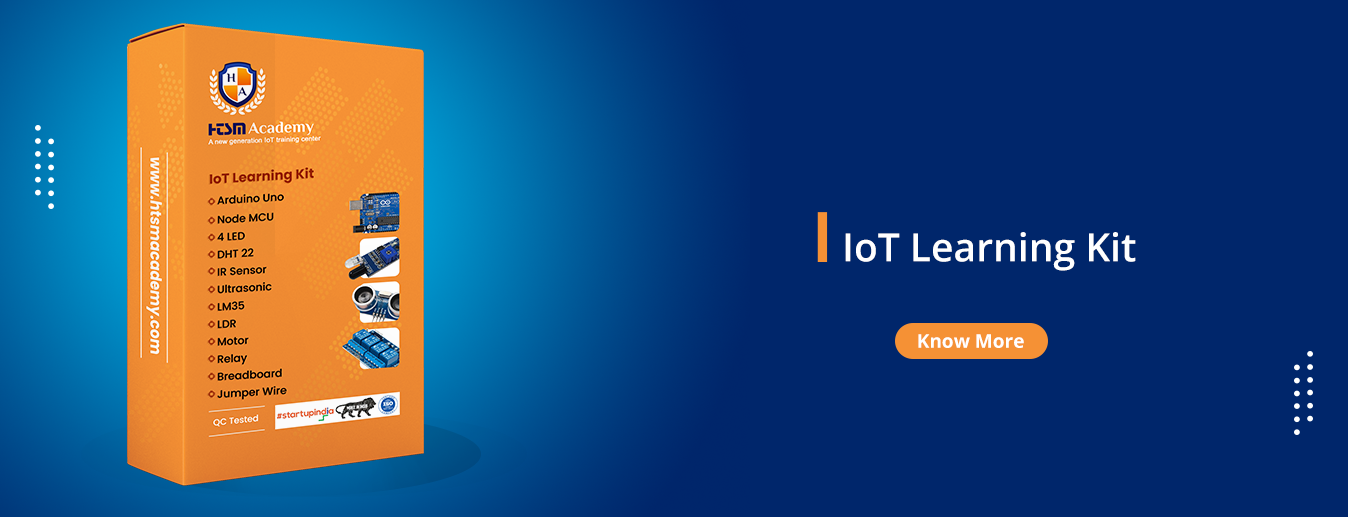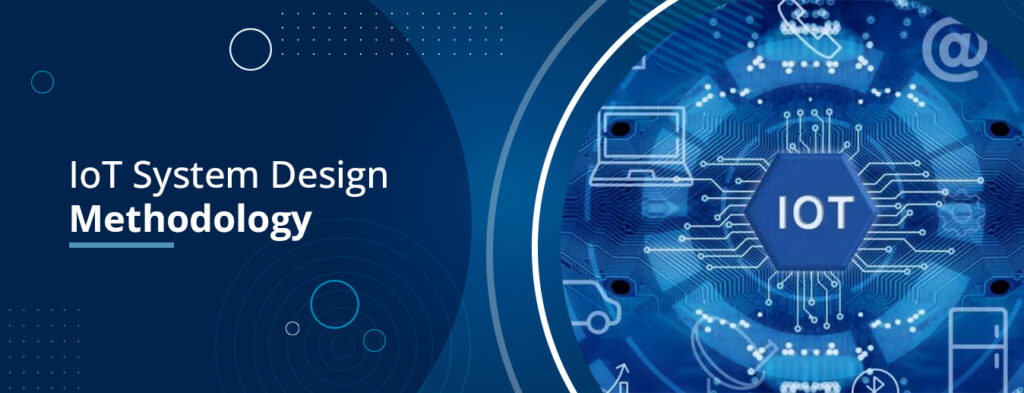The Internet of Things (IoT)is the next most happening thing on the Internet at present. However, it is critical to comprehend the IoT’s precise nature and the reasons for the buzz it is generating in our society.
Connecting electronic devices (non-humans) to the internet is what the “internet of things” aims to do. Data analytics are used in these items. A tiny embedded system that can be as small as a postage stamp connected to the internet is capable enough of measuring the data.
What Is the IoT Learning Kit and What It Is Used For?
An IoTLearning kit consists of a Microcontroller Board , Sensors( Such as Temperature , Light, Distance, Moisture etc ) & Actuators(Such as Motor, Relay ,Valve etc) with circuitry hardware and Programming Code that is used to support microcontroller experimentation. Let us say you have a microcontroller that can perform a variety of amazing tasks, but in order to use it, you must first set up a collection of hardware and circuitry on your breadboard each time.
Smart engineers find this frustrating, especially when there are circuits that will be the same every time, such as power circuits. Briefly, development boards are built to facilitate prototyping and increase the efficiency of engineers.
Some of the Most Popular and Important IoT Learning Kits
In contrast to the other development kits, 4 development kits are immensely preferred by developers which significantly eases their work. The 4 best development kits are as follows:
Node MCU
NodeMCU is a low-cost open source IoT platform. It initially included firmware which runs on the ESP8266Wi-FiSoC from Espressif Systems, and hardware which was based on the ESP-12 module.
Features
| Official NodeMCU | NodeMCU Carrier Board | LoLinNodeMCU | |
| Microcontroller | ESP-8266 32-bit | ESP-8266 32-bit | ESP-8266 32-bit |
| NodeMCU Model | Amica | Amica | Clone LoLin |
| NodeMCU Size | 49mm x 26mm | 49mm x 26mm | 58mm x 32mm |
| Carrier Board Size | n/a | 102mm x 51mm | n/a |
| Pin Spacing | 0.9″ (22.86mm) | 0.9″ (22.86mm) | 1.1″ (27.94mm) |
| Clock Speed | 80 MHz | 80 MHz | 80 MHz |
| USB to Serial | CP2102 | CP2102 | CH340G |
| USB Connector | Micro USB | Micro USB | Micro USB |
| Operating Voltage | 3.3V | 3.3V | 3.3V |
| Input Voltage | 4.5V-10V | 4.5V-10V | 4.5V-10V |
| Flash Memory/SRAM | 4 MB / 64 KB | 4 MB / 64 KB | 4 MB / 64 KB |
| Digital I/O Pins | 11 | 11 | 11 |
| Analog In Pins | 1 | 1 | 1 |
| ADC Range | 0-3.3V | 0-3.3V | 0-3.3V |
| UART/SPI/I2C | 1 / 1 / 1 | 1 / 1 / 1 | 1 / 1 / 1 |
| WiFi Built-In | 802.11 b/g/n | 802.11 b/g/n | 802.11 b/g/n |
| Temperature Range | -40C – 125C | -40C – 125C | -40C – 125C |
| Product Link | NodeMCU | NodeMCU |
ESP 32
ESP32 is a series of low-cost, low-power system on a chipmicrocontrollers with integrated Wi-Fi and dual-mode Bluetooth. The ESP32 series employs either a TensilicaXtensa LX6 microprocessor in both dual-core and single-core variations, Xtensa LX7 dual-core microprocessor or a single-coreRISC-V microprocessor and includes built-in antenna switches, RFbalun, power amplifier, low-noise receive amplifier, filters, and power-management modules. ESP32 is created and developed by Espressif Systems, a Shanghai-based Chinese company, and is manufactured by TSMC using their 40 nm process.It is a successor to the ESP8266 microcontroller.
Features of the ESP32 include the following:
- Processors:
- CPU: Xtensa dual-core (or single-core) 32-bit LX6 microprocessor, operating at 160 or 240 MHz and performing at up to 600 DMIPS
- Ultra low power (ULP) co-processor
- Memory: 320 KiB RAM, 448 KiB ROM
- Wireless connectivity:
- Wi-Fi: 802.11 b/g/n
- Bluetooth: v4.2 BR/EDR and BLE (shares the radio with Wi-Fi)
- Peripheral interfaces:
- 34 × programmable GPIOs
- 12-bit SAR ADC up to 18 channels
- 2 × 8-bit DACs
- 10 × touch sensors (capacitive sensing GPIOs)
- 4 × SPI
- 2 × I²S interfaces
- 2 × I²C interfaces
- 3 × UART
- SDIO/SPI slave controller
- Ethernet MAC interface with dedicated DMA and planned IEEE 1588 Precision Time Protocol support
- CAN bus 2.0
- Infrared remote controller (TX/RX, up to 8 channels)
- Motor PWM
- LED PWM (up to 16 channels)
- Ultra low power analog pre-amplifier
- Security:
- IEEE 802.11 standard security features all supported, including WPA, WPA2, WPA3 (depending on version)and WLAN Authentication and Privacy Infrastructure (WAPI)
- Secure boot
- Flash encryption
- 1024-bit OTP, up to 768-bit for customers
- Cryptographic hardware acceleration: AES, SHA-2, RSA, elliptic curve cryptography (ECC), random number generator (RNG)
- Power management:
- Internal low-dropout regulator
- Individual power domain for RTC
- 5 μA deep sleep current
- Wake up from GPIO interrupt, timer, ADC measurements, capacitive touch sensor interrupt
3. Raspberry Pi
Basically, the Raspberry Pi Development Kit is a credit card size computer. It functions on operating systems based on Linux and is suitable for embedded projects. Your computer, TV, and monitor can all be connected with ease by Raspberry boards. Even inexperienced users rely on it to set up their digital media systems and surveillance cameras.
Features:
- Processor: 1.2GHz quad-core ARMv8 CPU with 64-bit architecture.
- Wireless LAN 802.11n
- Combining a composite video connector and a 3.5mm audio jack
- Bluetooth 4.1
- 4 USB ports
- (BLE) Bluetooth Low Energy
- 1GB RAM
- 40 GPIO pins
- Full HDMI port
- Micro SD card slot
- Camera interface (CSI)
- VideoCore IV 3D graphics core
4. Arduino Nano 33 IoT
The Arduino Nano 33 IoT is an excellent tool with a dual-processor for experimentation.
It provides a useful and affordable option for creators who have little to no prior networking experience but want to add Wi-Fi connectivity to their projects.
The board works fine with the Arduino IoT Cloud, which enables you to develop IoT applications in a few easy steps.
Features:
- SAMD21 32-bit ARM Cortex-M0 processor
- 8 analogue input pins and 14 digital I/O pins are available.
- Resolutions of up to 12-bit ADC/PWM and 10-bit DAC are supported.
- Can function as several different USB devices, including (asynchronous serial, keyboard or mouse), HID, and USB MIDI.
- A built-in real-time clock module.
5. Banana Pi
One brand of affordable single-board computers (SBCs) available in the size of a credit card is called Banana Pi. It is a router-based development board that works well with OpenWRT and Android, as well as Lubuntu, Ubuntu, Debian, and Raspbian.
Since it is compatible with Raspberry Pi boards, the hardware design of the Banana Pi was influenced by the Raspberry Pi.
Features:
- All winner A20 Dual-core CPU, with a clock speed of 1.0 GHz
- Open GL ES 2.0/1.1 and Mali-400 MP2.
- DDR3 memory of 1 GB.
- 1 Gigabit LAN port
- 1x SATA interface
- 1X MIC
- 2 USB 2.0 and 1 USB OTG
- HDMI output
- Camera interface for CSI
- DSI interface for displays
6. Omega 2
One of the Linux-based Wi-Fi development boards from Onion is the Omega 2, which enables engineers of all skill levels to create interconnected hardware.
A strong processor and adaptable GPIOs are included on this highly integrated board. By combining high-level programming languages like Python, JavaScript, and PHP with well-known tools like Git, npm, and pip, the Platform enables you to prototype hardware devices.
Features:
- Powerful processor, Linux operating system, and adaptable GPIOs.
- Compact size that easily integrates into any project design.
- Exceptional flexibility is provided by modular design.
- compatible with Arduino.
- built-in Wi-Fi;
- GPS, Bluetooth®, Bluetooth Low Energy (BLE), Ethernet, 2G, and 3G networks are all available.
- Certified by the FCC and CE.
Wrapping Up
These 4 top development kits should be able to meet the needs of your various IoT projects. But if you are still daunted or perplexed by these options, you might seek assistance from IoT service providers who will help you choose the best development kit.
Therefore, there is no need to stress out or make hasty plans; simply get in touch with us right away. HTSM, as a top IoT development service provider, will help you choose the best IoT development kit specifically tailored for your upcoming IoT project while keeping your requirements in mind.





